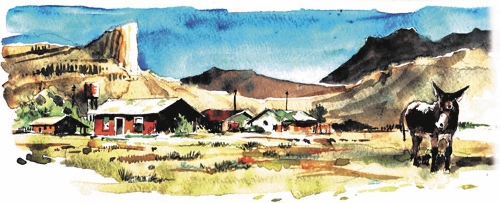Oatman’s tourist draws make it a lively destination
A former mining boomtown, Oatman, Ariz., enjoys life today as a popular tourist destination located near the Colorado River casinos and resorts at Laughlin. At least a half a million people a year seek out Oatman's authentic Old West atmosphere bolstered by noisily entertaining gunfights, special events and charming wild burros working the crowds for treats.
Visitors from Las Vegas take U.S. 95 south and Highway 163 to reach the Laughlin-Bullhead City area 90 miles south of Las Vegas. Oatman sits astride Historic Route 66, about 30 minutes' drive from the river. From Laughlin, visitors choose either an all-paved route or a shorter, partially paved back road to the ghost town. To reach either route, cross the river on the bridge from Laughlin to Bullhead City and head south paralleling the river on Arizona Highway 95.
For the paved route, follow this highway about 15 miles to Boundary Cone Road, turn left and head east about 12 miles to Old Route 66. Turn left and drive north about two miles to Oatman.
About a half-mile before you reach the town, note the sign for the Oatman Stables. Many visitors to Oatman include a guided horseback ride through the surrounding desert or a stagecoach ride through town. Horseback adventures cost $25 for a half-hour, $35 for an hour and $60 for two hours. Reserve your ride by calling the stable at (928) 788-1764 or online at www.oatmanstables.com.
For the shorter route, turn east at a stoplight in Bullhead City onto Silver Creek Wash Road. Paved for the first few miles, this street becomes a graded road as it climbs from the river toward the distinctive mountains around Oatman, about 17 miles away. When this road reaches Old U.S. 66, turn right to Oatman. Those mountains and parts of Oatman itself seem familiar to fans of Western movies, for the boomtown served as a film location, notably for the end scenes of the epic Western "How the West Was Won."
Oatman began as a tent town around mines developed after the discovery of gold in 1902. At first called Vivian after its principal mining company, the new town changed its name in 1909 to Oatman, after Olive Oatman, a survivor of a Yavapai Apache massacre of an immigrant family in Central Arizona in the early 1850s. Traded to Mohave Indians, Olive Oatman spent five years living along the Colorado until her rescue in 1857. By then, she bore tribal tattoos upon her face.
Look for information about Olive Oatman at the Oatman Hotel, one of the town's original buildings, a two-story adobe structure built in 1902. The hotel became a favorite with travelers on Route 66, the Mother Road from middle America to the Pacific coast laid out in the 1920s. The hotel gained fame when movie stars Clark Gable and Carole Lombard stopped overnight after their March 1939 marriage in Kingman.
The hotel survived a fire in the early 1920s that swept away many of Oatman's early buildings. Once one of Arizona's top gold producers, Oatman took a hit in 1924 when its biggest mine closed. In 1941, the federal government mandated that miners turn to mining materials essential to the war effort. Oatman dwindled but still could rely on traffic along U.S. 66. In 1952, interstate traffic was diverted from U.S. 66. Oatman's population soon dropped to about 60 residents.
Most thought the town was dead, but Oatman re-created itself. Building upon its proximity to Laughlin and later on the popularity of Historic Route 66 as a nostalgia highway, it became a tourist destination. Today, about 40 shops, cafes and bars line Oatman's main street, part of Historic Route 66. Tourists throng the town's eateries, crowd to imbibe bar beverages, wait in line to indulge in ice cream and gather to take pictures of the burros, descendants of old-time pack animals.
Most businesses stock carrots or pellets for the burros. About a dozen burros come in from the desert to hang out downtown, sometimes with spring foals at their sides. Traffic stops, for the burros have the right-of-way. The burros hardly notice when the Ghost Riders gunfighters stage their street confrontations at 1:30 and 3:30 each afternoon.
The creatures remain immensely popular with Oatman's tourists, which long ago replaced gold as Oatman's lifeblood.
Margo Bartlett Pesek's column appears on Sundays.






















